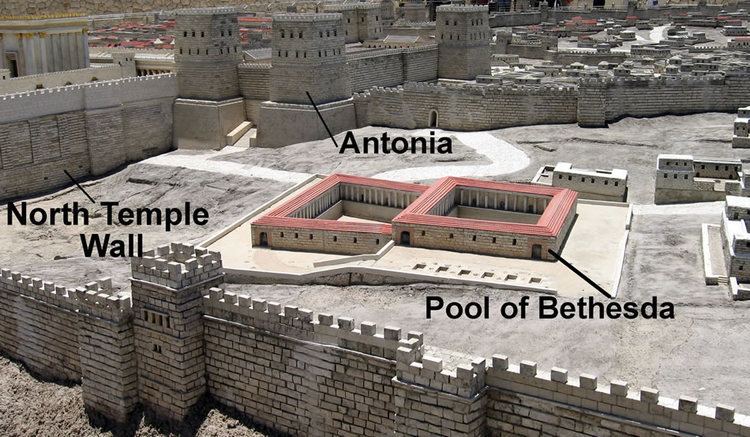 | ||
Similar Via Dolorosa, Mount of Beatitudes, Church of Saint Anne - Jerusalem, Pool of Siloam, Mount of Olives | ||
Pool of bethesda jerusalem
The Pool of Bethesda is a pool of water in the Muslim Quarter of Jerusalem, on the path of the Beth Zeta Valley. The fifth chapter of the Gospel of John describes such a pool in Jerusalem, near the Sheep Gate, which is surrounded by five covered colonnades. It is associated with healing. Until the 19th century, there was no evidence outside of John’s Gospel for the existence of this pool; therefore, scholars argued that the gospel was written later, probably by someone without first-hand knowledge of the city of Jerusalem, and that the "pool" had only a metaphorical, rather than historical, significance.
Contents
- Pool of bethesda jerusalem
- Pool of bethesda
- Name
- Relationship to the biblical Jesus
- Gospel of John
- Archaeology
- History
- References
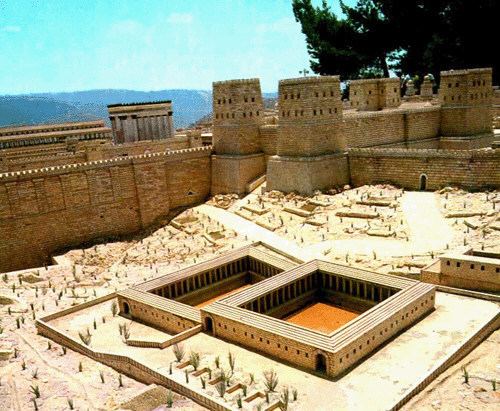
In the 19th century, archaeologists discovered the remains of a pool fitting the description in John’s Gospel.
Pool of bethesda
Name
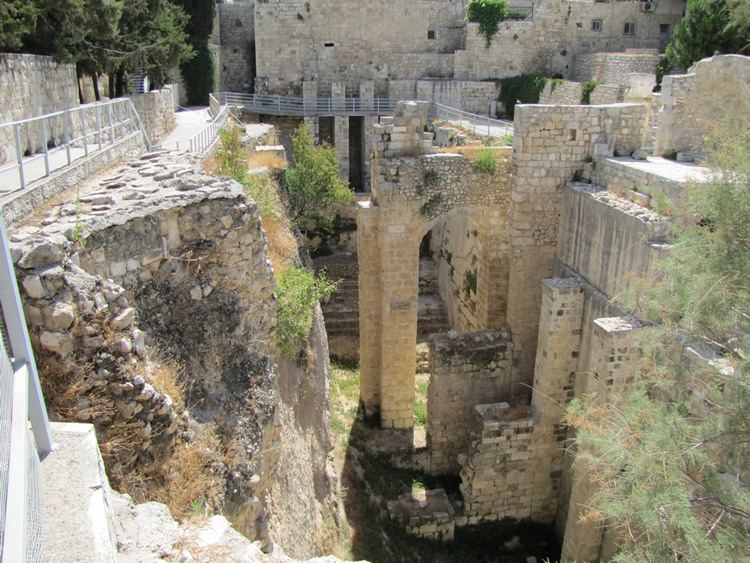
The name of the pool is said to be derived from the Hebrew language and/or Aramaic language. Beth hesda (בית חסד/חסדא), meaning either house of mercy or house of grace. In both Hebrew and Aramaic the word could also mean "shame, disgrace". This dual meaning may have been thought appropriate, since the location was seen as a place of disgrace due to the presence of invalids, and as a place of grace due to the granting of healing.
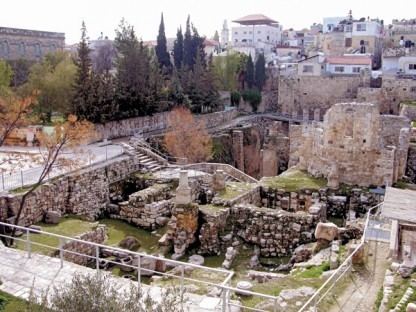
Alternative renderings to the name Βηθεσδά (Bethesda), appearing in manuscripts of the Gospel of John, include Βηθζαθά (Beth-zatha = בית חדתא), a derivative of Bezetha, and Bethsaida (not to be confused with Bethsaida, a town in Galilee), although the latter is considered to be a metathetical corruption by Biblical scholars.
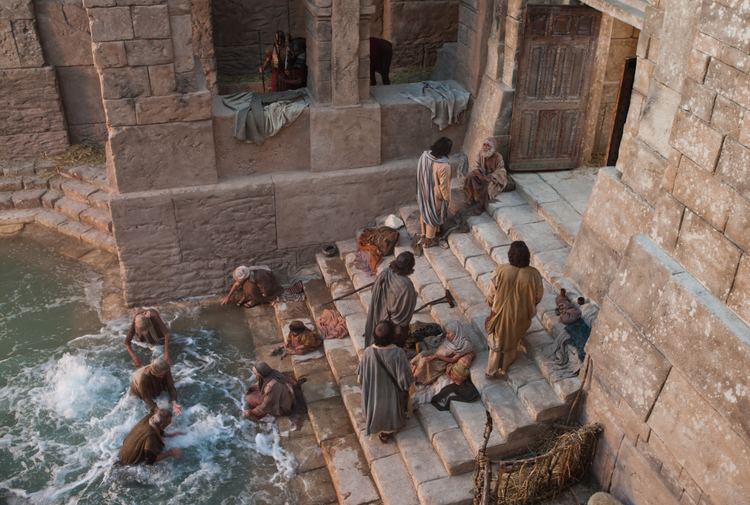
Delitzsch (“Talmudische Studien, X. Bethesda”, Zeitschrift für die gesamte lutherische Theologie und Kirche, 1856) suggested that the name comes from a mishnaic Hebrew loanword from Greek, estiv/estava, that appropriately referred to στοά.
Relationship to the biblical Jesus
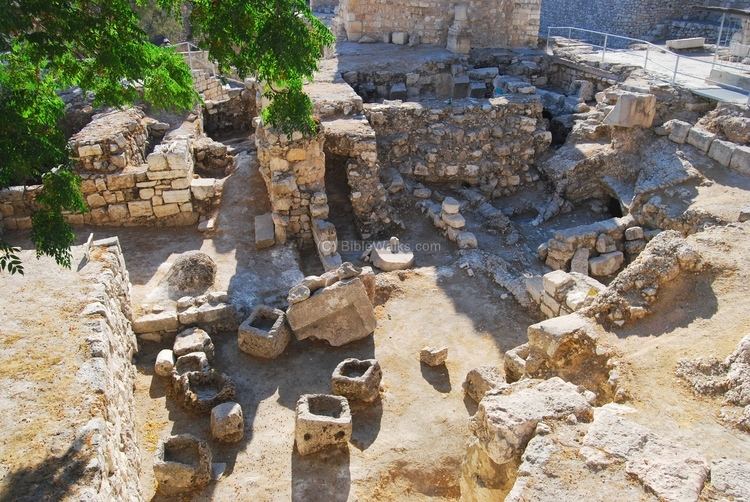
The Pool of Bethesda has been an area of controversy for Christian historians and archaeologists alike. According to the Gospel of John, Bethesda was a swimming bath (Greek: κολυμβήθρα, kolumbethra) with five porticos (translated as porches by older English Bible translations).
Gospel of John
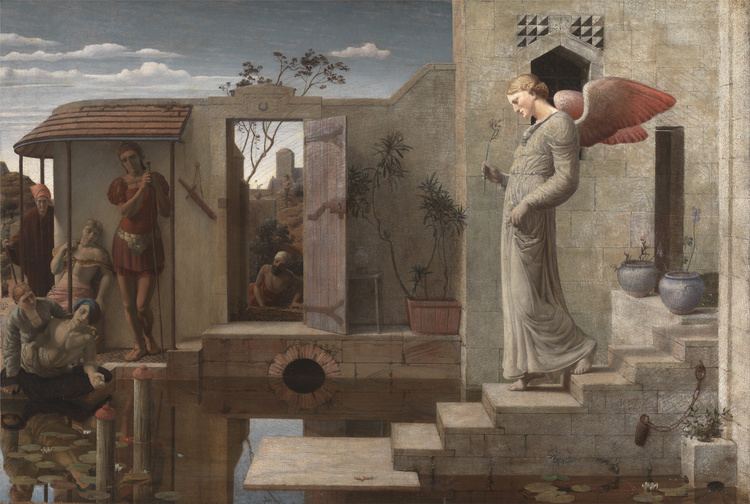
The Johannine narrative (chapter 5) describes the porticos as being a place in which large numbers of infirm people were waiting, which corresponds well with the site's 1st century AD use as an asclepieion. Some ancient biblical manuscripts argue that these people were waiting for the troubling of the water; a few such manuscripts also move the setting away from Roman rituals into something more appropriate to Judaism, by adding that an angel would occasionally stir the waters, which would then cure the first person to enter. Although the Vulgate does not include the troubling of the water or the "angel tradition", these were present in many of the manuscripts used by early English translations of the Bible, who therefore included it in their translations. Modern textual scholarship views these extra details as unreliable and unlikely to have been part of the original text; many modern translations do not include the troubling of the water or the "angel tradition", but leave the earlier numbering system, so that they skip from verse 3a straight to verse 5.
The biblical narrative continues by describing a Shabbat visit to the site by Jesus, during which he heals a man who has been bedridden for many years, and could not make his own way into the pool. Some scholars have suggested that the narrative is actually part of a deliberate polemic against the Asclepius cult, an antagonism possibly partly brought on by the fact that Asclepius was worshipped as Saviour (Greek: Soter), in reference to his healing attributes. The narrative uses the Greek phrase "ὑγιὴς γενέσθαι", hygies genesthai, which is not used anywhere in the Synoptic Gospels, but appears frequently in ancient testimonies to the healing powers of Asclepius; the later narrative in the Gospel of John about Jesus washing Simon Peter's feet at the Last Supper, similarly uses the Greek term "λούειν", louein, which is a special term for washing in an Asclepieion, rather than the Greek word used elsewhere in the Johannine text to describe washing – "νίπτειν", niptein.
Archaeology
Prior to archaeological digs, the Pool of Bethesda was identified with the modern so-called Fountain of the Virgin, in the Kidron Valley, not far from the Pool of Siloam, and alternately with the Birket Israel, a pool near the mouth of the valley, which runs into the Kidron south of St. Stephen's Gate. Others identified it with the twin pools then called the Souterrains (French for "Subterranean"), under the Convent of the Sisters of Zion; subsequent archaeological investigation of the area has determined these to actually be the Strouthion Pool.
In digs conducted in the 19th century, Conrad Schick discovered a large tank situated about 100 feet (30 m) north-west of St. Anne's Church, which he contended was the Pool of Bethesda. Further archaeological excavation in the area, in 1964, discovered the remains of the Byzantine and Crusader churches, Hadrian's Temple of Asclepius and Serapis, the small healing pools of the Asclepieion, the other of the two large pools, and the dam between them. It was discovered that the Byzantine construction was built in the very heart of Hadrian's construction and contained the healing pools.
History
The history of the pool began in the 8th century BC, when a dam was built across the short Beth Zeta valley, turning it into a reservoir for rain water; a sluice-gate in the dam allowed the height to be controlled, and a rock-cut channel brought a steady stream of water from the reservoir into the city. The reservoir became known as the Upper Pool (בריכה העליונה). Around 200 BC, during the period in which Simon II was the Jewish High Priest, the channel was enclosed, and a second pool was added on the south side of the dam; although popular legend argues that this pool was used for washing sheep, this is very unlikely due to the pool's use as a water supply, and its extreme depth (13m).
In the 1st century BC, natural caves to the east of the two pools were turned into small baths, as part of an asclepieion; however, the Mishnah implies that at least one of these new pools was sacred to Fortuna, the goddess of fortune, rather than Asclepius, the god of healing. Scholars think it likely that this development was founded by the Roman garrison of the nearby Antonia Fortress, who would also have been able to protect it from attack the location of the asclepieion, outside the then city walls, would have made its presence tolerable to the Jews, who might otherwise have objected to a non-Jewish religious presence in their holy city.
In the mid 1st century AD, Herod Agrippa expanded the city walls, bringing the asclepieion into the city. When Hadrian rebuilt Jerusalem as Aelia Capitolina, he placed a roadway along the dam, and expanded the asclepieion into a large temple to Asclepius and Serapis. In the Byzantine era, the asclepieion was converted to a church.
After the Crusader conquest of Jerusalem, the church buildings were rebuilt on a smaller scale with a new church erected nearby. This new church, named for Saint Anne and completed in 1138 AD., was built over the site of a grotto believed by the Crusaders to be the birthplace of Anne, grandmother of Jesus. After the conquest of Jerusalem by Saladin it was transformed into a Shafi`i fiqh (Islamic law school). Gradually the buildings fell into ruin, becoming a midden (waste dump). In the early 19th century, the Ottoman Empire, as an act of gratitude, offered Queen Victoria the choice of possessing the Bethesda site or Cyprus; the Anglican church lobbied for the Bethesda site, but Victoria chose Cyprus, so in 1856, the Ottomans gave the site to France instead. The French constructed the Church of Saint Anne, at the south east corner of the site, leaving the ancient ruins untouched.
